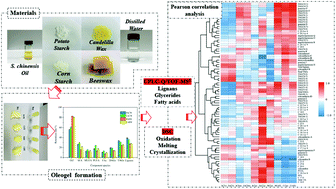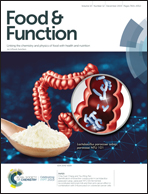Thermal and oxidation stability of functional oleogels formed by edible wax/starch and Schisandra chinensis oil†
Abstract
This work was aimed at the evaluation of stability of components in oleogels and providing a quick, visual description of the relationship between the composition of an oleogel and its thermal and oxidation properties. Composition stability analysis indicated that almost all oleogel components, including approximately 24 fatty acids (FAs), seven diglycerides (DAGs), 21 triglycerides (TAGs) and 19 lignans, were inherited from the precursor oil. The oil content among different oleogels ranged from 56.17 to 82.25%, and the oleogels made with candlestick wax (CW) showed higher component stability. Non-isothermal crystallization (C), melting (M) and oxidation analysis of the oleogels by differential scanning calorimetry (DSC) showed slight differences among the various oleogels. For visual analysis, seven components had significant positive relationships with k(Ts) and Ea(Ts), and 18 FAs, 10 glycerides and four lignans had significant positive relationships with k(Tp) and Ea(Tp). As for C(Tp) and C(ΔH), nine lignans, 13 glycerides and three FAs exhibited a notable positive correlation with k(Tp). These results might provide guidance for designing oleogel features and a new application perspective on the stability of solidified oils.



 Please wait while we load your content...
Please wait while we load your content...